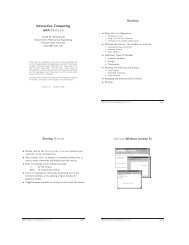"O Soul, Come Back!" A Study in The Changing Conceptions of The ...
"O Soul, Come Back!" A Study in The Changing Conceptions of The ...
"O Soul, Come Back!" A Study in The Changing Conceptions of The ...
You also want an ePaper? Increase the reach of your titles
YUMPU automatically turns print PDFs into web optimized ePapers that Google loves.
388 YING-SHIH YUMount T'ai 4[ti, the sacred mounta<strong>in</strong> <strong>in</strong> ancient Ch<strong>in</strong>a, as apreparation for his f<strong>in</strong>al ascension to heaven. At this time a storyhad been fabricated that the legendary Yellow Emperor did not reallydie but flew to heaven on a dragon's back together with hiscourt assistants and palace ladies after hav<strong>in</strong>g performed imperialsacrifices to Heaven and Earth at the central peak <strong>of</strong> Mount T'ai.Taken <strong>in</strong> by this story, Emperor Wu made his imperial pilgrimageto Mount T'ai <strong>in</strong> 110 B.C. and carried out all the religious ritualssupposedly <strong>in</strong> the tradition <strong>of</strong> the Yellow Emperor. He returned tothe capital assured that he would eventually jo<strong>in</strong> the YellowEmperor <strong>in</strong> heaven as a hsien immortal. By the turn <strong>of</strong> the first centuryA.D., at the latest, the cult <strong>of</strong> hsien immortality had alreadyspread from royal and aristocratic circles to the common people. AHan stone <strong>in</strong>scription relates that, <strong>in</strong> A.D. 7, a yamen underl<strong>in</strong>g <strong>in</strong>the local government <strong>of</strong> Han-chung iMv (<strong>in</strong> modern Shensi) namedT'ang Kung-fang )AK2f succeeded <strong>in</strong> his pursuit <strong>of</strong> hsien immortality.Consequently, he ascended heaven not only with his whole familybut also his house and domestic animals.<strong>The</strong> great popularity <strong>of</strong> this cult transformed the Han conception<strong>of</strong> the afterlife <strong>in</strong> a fundamental way. Accord<strong>in</strong>g to the T'ai-p'<strong>in</strong>gch<strong>in</strong>g, only the hsien immortals who had embodied the great Taowere admitted to heaven.64 S<strong>in</strong>ce the immortal hsien and thedissolvable hun were conceived as belong<strong>in</strong>g to two completelydifferent categories <strong>of</strong> be<strong>in</strong>gs, they were not supposed to mix <strong>in</strong> thesame heaven. As a result, a new abode had to be found to accommodatethe hun souls. Thus, the governmental structure <strong>of</strong> theunderworld was expanded. Based on a variety <strong>of</strong> historical and archaeologicalevidence, this new conception <strong>of</strong> the underworld maybe briefly reconstructed as follows: First, from around the end <strong>of</strong> thefirst century B.C. a belief gradually arose that there was a supremeruler called Lord <strong>of</strong> Mount T'ai (T'ai-shanfu-chu<strong>in</strong> *[UffEr) whosecapital was located <strong>in</strong> a place named Liang-fu 3 a small hill nearMount T'ai.65 Liang-fu, it may be noted, was traditionally the place64TPC, p. 138.65For the development <strong>of</strong> the cult <strong>of</strong> Mount T'ai as a place for the dead, see also Chao I kLI, Kai-yii ts'ung-k'ao PPW ; (Shanghai: Commercial Press, 1957), 35.751-52; EdouardChavannes, Le T'at Ch 'an (Paris: Leroux, 1910), chapter six; Sakai Tadao i"Taizan sh<strong>in</strong>k6 no kenkyu " *OA {fA V fi A, Shicho 7.2 (June 1937).















